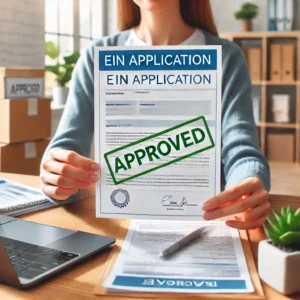 Did you just submit your EIN application? And now you get word that it was rejected. You’re not alone.
Did you just submit your EIN application? And now you get word that it was rejected. You’re not alone.
Many individuals have filed for an EIN only to discover that the application has been rejected. It’s frustrating if you are making plans to launch your own business. Don’t panic.
We will explore common reasons why your EIN was rejected and what you can do about it.
What is an EIN?
Let’s first define an EIN before listing all the rejection reasons. An Employer Identification Number, or EIN, is a nine-digit number assigned by the IRS, similar to a Social Security number, but used for businesses.
You’ll need an EIN in order to file taxes, hire employees, open a business bank account, and apply for business licenses.
Now that you know what an EIN is, let’s move on to why it may have been declined.
Reasons Your EIN Was Declined
Duplicate Application
You requested an EIN recently? The IRS might reject a new application if they find one already submitted. This could be due to:
- You accidentally submitted the form more than once.
- You filed under a different name, but the business information is the same.
How to Fix It: Search your files. If you had previously applied for an EIN and have forgotten, you might not need to apply for a new one. Contact the IRS and recover your EIN. If you believe you submitted the form multiple times, just wait for the IRS to process your first application instead of duplicating it.
Incomplete or Inaccurate Information
The main reason why applications get rejected at EIN is incomplete or incorrect information. The IRS is very particular about the details you give. A simple spelling error of your name, a wrong Social Security number, or omitting important information can lead to rejection.
How to Fix It: Carefully read over your application for an EIN before you send it in. Be sure that your name, address, and Social Security number are correct. Be sure you didn’t miss a required section and have double-checked each of those fields.
Business Name or Structure Not Consistent
A mismatch in business name or type could lead to rejection at the IRS. For example, you submitted your business as an LLC in one form and as a Sole Proprietorship in another form. The IRS will flag that as inconsistency and reject your application.
How to Fix It: Maintain consistency across the entire application. Business name, structure, and other information should be identical across all forms submitted. It is a good idea to consult a legal expert or accountant if you are unsure of your business structure prior to applying.
Use of a Prohibited Name
Certain names are forbidden and cannot be used in an application for EIN. For example, when your business name contains the word “Federal” or “National,” the IRS will reject it since such names can be misunderstood to suggest affiliation with the government.
How to Fix It: If your application was rejected because of a name restriction, then you’ll have to change the name of your business. Avoid using words that might convey a relation with the government or are trademarked by another business. In all instances, ensure that the chosen business name is available and allowed.
Already Exists EIN for the Same Entity
You can try to get the EIN again, but this time you will most likely be rejected because the IRS forbids holding multiple EINs within one business; however, there are exceptions—such as if you converted from a sole proprietorship to a corporation.
Before re-applying, ensure you check with your business if it already has an EIN. If you lose it, you can retrieve your EIN by contacting the IRS or checking your tax returns or business account statements.
 How to Avoid EIN Rejection Next Time
How to Avoid EIN Rejection Next Time
However, since you’re now equipped with knowledge about several reasons why your EIN application might have been rejected, let’s begin with some advice on how you can avoid such rejections for the next application process:
Do Your Research Double
Well, it’s really just plain and simple, but this is actually the most important step: before you even submit the form, review every detail carefully. This means all of these must be reviewed accurately:
- Legal name
- Social Security number (or Individual Taxpayer Identification Number)
- Business structure
- Business address
Be Consistent
Make sure that your business structure and name are consistent in all of your documents. If you’re not sure which type of business structure you want to use (LLC, Corporation, etc.), be sure to speak with a lawyer or tax professional first.
Use the Correct Form
There is a different form for every type of business. For example, a corporation and a non-profit will not use the same form. Be sure you are using the correct form for your own type of business.
Avoid Confusing or Restricted Names
Some names will confuse the IRS or are restricted. For instance, you should never use any name that contains a term like “Federal,” “United States,” or any other name that may imply government involvement.
You should also avoid using any business name that would be a trademark.
Contact the IRS for Help
For those times when you’re just unsure, do not be afraid to contact the IRS for an explanation. The IRS offers support information on its website.
You may also contact the IRS directly to assist in your EIN application. Sometimes a little bit of help upfront will save you a whole lot of headaches later on.
What to Do When Your EIN Was Rejected
If the IRS rejects your application for an EIN, do not worry because you can correct it. Here’s how you do that:
- Know what went wrong. The IRS rejection letter will detail why it was denied. Read the reply to you closely.
- Fix it: Correct the error you determined. A typo? Correct it. A duplicate application? Wait for the IRS to process the original one.
Once you have the corrected version, you can again apply for an EIN. Do all things from scratch this time.
Conclusion
The rejection of an EIN is frustrating; however, it is not over. All you need to do is understand why it was rejected, correct errors, and apply again with the correct information. Follow the tips from this article to avoid pitfalls and get your EIN the easy way.
Remember, as important as it is that you have an EIN in order to operate a business, getting it right is worthwhile.
Should you ever need to have anything clarified about your EIN, do not be afraid to seek assistance from the IRS or a professional advisor. Good luck with your new business!
For further assistance with EIN applications, check out our EIN page. Also, you can check for more information on the IRS.
Want to know more about the process? Throw your questions in the comments below!

 How to Avoid EIN Rejection Next Time
How to Avoid EIN Rejection Next Time